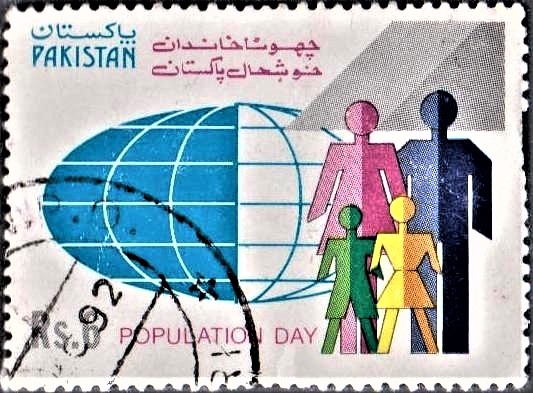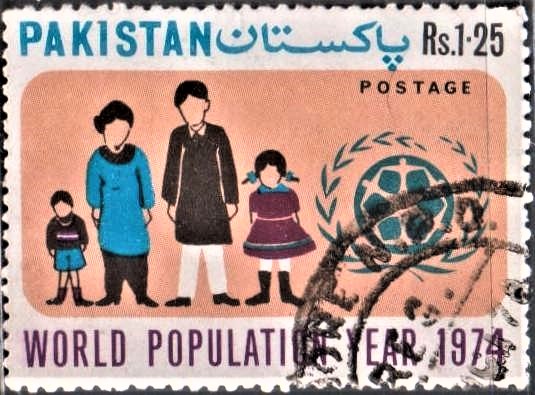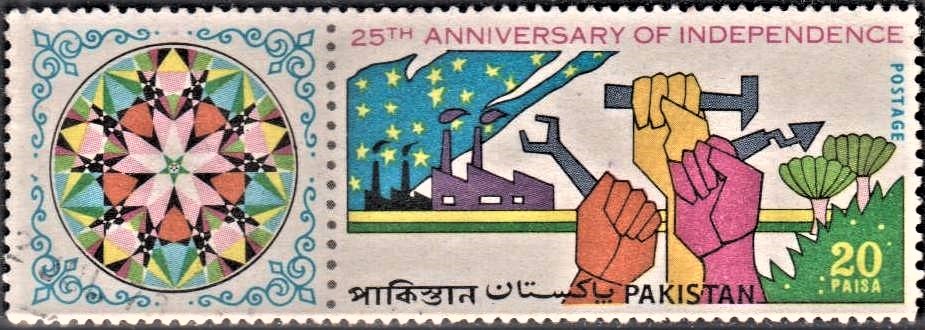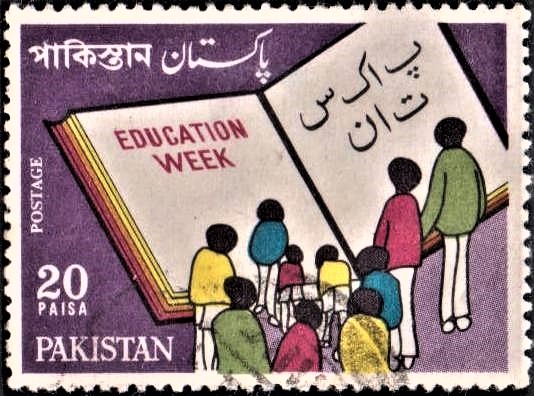
Pakistan on International Literacy Year 1990
A commemorative postage stamp on the International Literacy Year (ILY) 1990 :
 Issued by Pakistan
Issued by Pakistan
Issued on Sep 8, 1990
Issued for : Pakistan Post Office has decided to commemorate the occasion through issuing a commemorative postage stamp of Rs. 3/- denomination on September 8, 1990 on the INTERNATIONAL LITERACY YEAR 1990.
Designer : Syed Ali Afsar (PSPC)
Type : Stamp, Postal Used
Denomination : Rs. 3/-
Colour : Multi colour
Size of Stamp : 50.8 x 35.2 mm
Size of Print : 47 x 31 mm
Perforation : 13C
Paper : 102 gsm dual purpose coated PVA gum
Quantity : One million
Number of stamps in a sheet : 60 (12 x 5 rows)
Process of Printing : Litho Offset
Printer : Pakistan Security Printing Corporation
About :
- Introduction
- Eradication of illiteracy is a major global concern. As a result, of expansion of facilities for children’s education and a variety of activities aiming at promotion of Adult Literacy, the rate of illiteracy throughout the world is declining. The illiteracy rate in the world decreased from 32.9 percent in 1970 to 27.7 percent in 1985. Nonetheless, in absolute terms, during this period, the number of illiterate adults has increased because of rapid population growth. It is estimated that number of adult illiterates aged 15 and above rose from 760 million in 1970 to 889 million in 19851.
- Over 98 percent of the world’s illiterates live in developing countries, about 666 million living in Asia2. Majority of adult illiterates are women.The United Nations General Assembly in December, 1987, adopted a resolution declaring 1990 as the International Literacy Year (ILY) to trigger off the efforts for the promotion of literacy and basic education.
- Objectives
- The objectives for International Literacy Year approved by the twenty-fourth session of the UNESCO General Conference in the autumn of 1987 are:
- i) Increasing action by the governments of Member States afflicted by illiteracy or functional illiteracy to eliminate these problems, particularly through education in rural areas and urban slums, in favour of women and girls and among populations and groups having special educational problems or needs.
- ii) Increasing public awareness of the scope, nature and implications of illiteracy as well as of the means and conditions for combating it, in particular, an effort should be made to alert public opinion to the rate of illiteracy among adult women and its implications for the well-being of their children, the lower rate of school participation among girls than among boys and the association between illiteracy, on the one hand, and poverty, under-development and economic, social and cultural exclusion on the other;
- iii) Increasing popular participation, within and among countries, in efforts to combat illiteracy, particularly through activities of governmental and non-governmental organizations, voluntary associations and community groups;
- iv) Increasing co-operation and solidarity among Member States in the struggle against illiteracy;
- v) Using International Literacy Year for launching the Plan of Action for the eradication of illiteracy by the year 2000 and for addressing issues of critical importance to the progress of literacy such as reducing primary school drop-out and establishing post-literacy programmes to present relapse into illiteracy.
- The objectives for International Literacy Year approved by the twenty-fourth session of the UNESCO General Conference in the autumn of 1987 are:
- Literacy Situation in Pakistan
- The celebration of the International Literacy Year in a country like Pakistan having one of the lowest literacy rates among the Asian Countries is all the more necessary. According to 1981 census, the overall literacy rate among population aged 10 and above in the country was 26.17 percent, 35.05 percent for males and 16.00 percent for females.In Pakistan, illiteracy is more pronounced in rural areas and especially amongst rural females. The female literacy rates in rural areas of Punjab, Sindh, NWFP and Baluchistan were 9.4%, 5.2%, 3.8% and 1.8% respectively, as may be seen from Table 1 given below:–TABLE – 1
Province–wise Distribution of Literacy Rates among Population 10+ (1981 Census)S. No. Province/Area All Areas Urban Rural Both Sexes Male Female Both Sexes Male Female Both Sexes Male Female Pakistan 26.17 35.05 10.00 47.1 55.3 27.3 17.3 26.2 7.3 1. NWFP 16.7 25.9 6.5 35.8 47.0 21.9 13.2 21.7 7.8 2. Punjab 27.4 36.9 16.8 46.7 55.2 36.7 20.0 29.6 9.4 3. Sindh 31.5 39.7 21.6 50.8 57.8 42.2 15.8 24.5 5.2 4. Baluchistan 10.2 15.2 4.3 32.2 42.4 18.5 6.2 9.8 1.8
- The celebration of the International Literacy Year in a country like Pakistan having one of the lowest literacy rates among the Asian Countries is all the more necessary. According to 1981 census, the overall literacy rate among population aged 10 and above in the country was 26.17 percent, 35.05 percent for males and 16.00 percent for females.In Pakistan, illiteracy is more pronounced in rural areas and especially amongst rural females. The female literacy rates in rural areas of Punjab, Sindh, NWFP and Baluchistan were 9.4%, 5.2%, 3.8% and 1.8% respectively, as may be seen from Table 1 given below:–TABLE – 1
- Illiterate Population
- In absolute terms, the number of adult illiterates aged 10 and upward in the country are estimated to be about 48 million. About 10 million people join the ranks of illiterates every year. According to 1981 Census, the distribution of illiteracy population in the country is given in Table-2.
TABLE – 2
Distribution of Illiterate Population in Pakistan
(Figures in millions)S. No. Area Male Female Total 1. Pakistan 19,533 22,050 41,583 2. Punjab 11,057 12,886 23,943 3. Sindh 4,189 4,607 8,796 4. NWFP 2,900 3,274 6,174 5. Baluchistan 1,337 1,226 2,563
- In absolute terms, the number of adult illiterates aged 10 and upward in the country are estimated to be about 48 million. About 10 million people join the ranks of illiterates every year. According to 1981 Census, the distribution of illiteracy population in the country is given in Table-2.
- Celebration of International Literacy Year
- As stated earlier, the International Literacy Year 1990 in fact provides for a decade long plan of action for the complete eradication of illiteracy. The nature of activities proposed to be undertaken during the period from now and the year 2000 can be categorized as:–
- a) Planning at Literacy Programmes including universalization of basic education and making necessary preparations for their effective implementations including pilot experimental projects.
- b) Creation of a favourable climate by launching mass motivation campaign to ensure maximum participation of both literate and illiterate masses in literacy drives. The issuance of a Commemorative Postage Stamp is also a step in this direction.
- c) Effective implementation of programmes for complete eradication of illiteracy.
- As stated earlier, the International Literacy Year 1990 in fact provides for a decade long plan of action for the complete eradication of illiteracy. The nature of activities proposed to be undertaken during the period from now and the year 2000 can be categorized as:–
- References :
- 1. The current Literacy situation in the World, Office at Statistics, UNESCO, Paro, July 1985, DOC. St-85/WS-9.
- 2. Asia Pacific Programme of Education for All, Vol. 2, No. 1, 1988.
- (Contributed by : National Education & Training Commission).
- Issued by The Director General, Pakistan Post Office, Islamabad.







